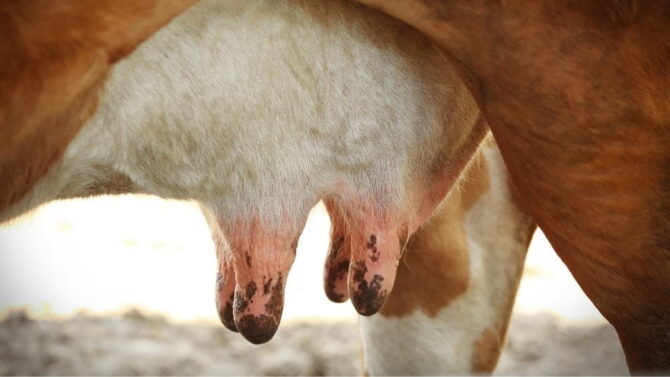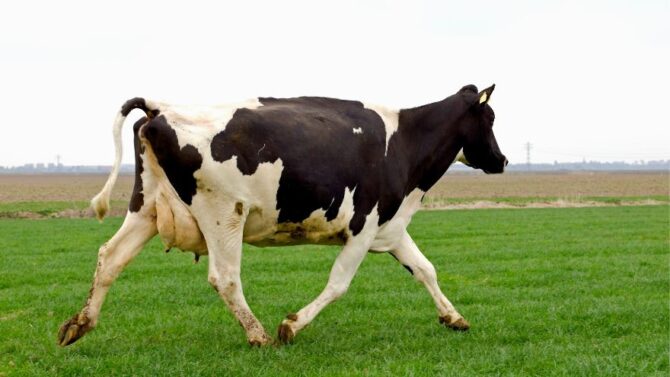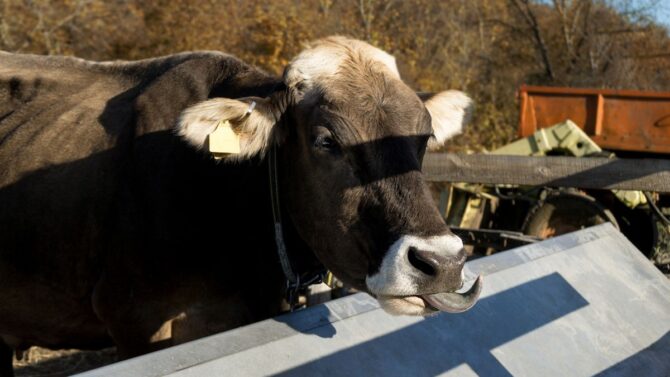Cows are domesticated mammals of the Bovidae family. They are often raised by humans for their work energy, milk, skin hide, meat, and even their dung (as manure).
You’d recognized them by their huge body, clove hooves, horns (for most), and whipping tail. The name ‘cow’ is the general term used for the species, but the male is specifically called a bull, and the baby a calf.
Cows may look sluggish and dumb, but they aren’t. From the provision of manure to giving meat down to being work animals, humans depend on them for a lot.
After being domesticated by humans around 10,000 years ago, they have served us well.
Scientific Classification
- Kingdom: Animalia
- Phylum: Chordata
- Class: Mammalia
- Order: Artiodactyla
- Family: Bovidae
- Subfamily: Bovinae
- Genus: Bos
- Species: B. Taurus
- Binomial Name: Bos Taurus
Characteristics
- Height: 5ft to 6ft
- Weight: 88 to 1,760 pounds
- Venom/Poison: No
- Habitat: Forest, grasslands
- Range: Worldwide
- Diet: Herbivore
- Life span: 12 to 20 years
- Gestation Period: 279 to 287 days
- Conservation status: Domesticated
5 Interesting Facts About Cows
1. Cows are faster than they appear
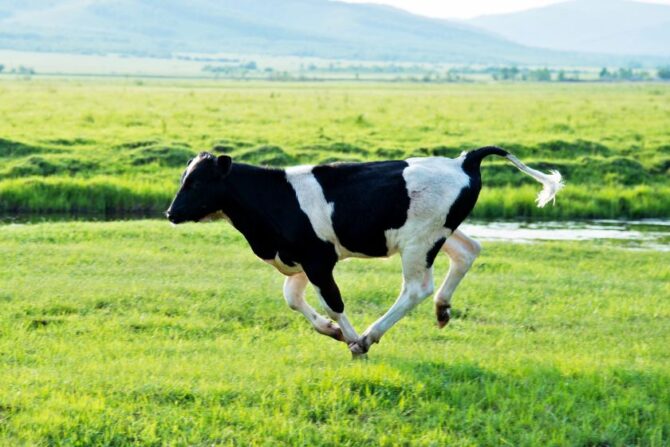
Though they seem slow because of their physique, cows are fast. Their average speed is 40km/h, which surpasses a donkey, a sheep, and even that of an average human.
They can’t maintain the speed for long, but given that their rate is close to that of Usain Bolt, they should not be underestimated in this aspect.
Besides their size, people don’t realize they are fast because these mammals don’t always run. They only do so if they’re startled or threatened. On a normal day, cows prefer walking.
2. They are as big as cars!
Cows differ in size, but they are big, with a weight that falls between 88 and 1,760 pounds. A big cow named Knickers is famous for being as tall as Michael Jordan and weighing as much as a car.
Their size also means that they will need a lot of food to eat and water to drink. Cows eat as much as 8 hours a day and will need more than 100 liters of water each day.
This is why herders keep them outside, where there would be enough water to drink and green grass to feed on.
3. Cows are sacred in some places
Because of how beneficial cows are, people have many positive ideas about them, some bordering on the sacred.
They are considered as mothers in the Hindu religion, making it forbidden to kill one. Other religions that consider cows sacred include Buddhism and Jainism.
4. They are good at solving problems
Another underrated quality of a cow is its intelligence, which stems from another misconception about its size. Because they’re big, they aren’t considered intelligent.
That can’t be further from the truth. These animals are intelligent, with the ability to solve problems and remember faces. Going by the results of this study, they might even be smarter than dogs.
5. Cows have emotions
Closely tied to their intelligence is the ability to feel more complex emotions than we give them credit for.
Cows develop friendships, interact with themselves, are scared of death, recognize people who treated them well or badly and can keep grudges against those around them.
General Description
Also called cattle as a group, cows are common farm animals that is a constant part of many farm settlements since Ancient civilizations.
They share some features with other farm animals—like hooves, tails, and a herbivorous diet—but have their unique appearance.
Amongst themselves, there are also differences in looks. Cows don’t have the same colors, sizes, and shapes. The breed determines to a large extent, how an individual will turn out to be.
Take the size as an example. The average cow is expected to weigh up to 1,500 pounds, a few sizes short of a small car.
Some breeds are bigger than the average; others are smaller. The Chianina is over 3,700 pounds while the Dexter is at 750.
Some cow breeds have short hair; others grow longer. The colors and patterns vary too. The common pattern is known as the Holstein style, which has an irregular black-and-white pattern.
A variant of the Holstein style is the red Holstein style, where the black-and-white becomes reddish brown. Some like the Angus, are black from head to tail, and there are many other color combinations.
Generally, all cows have horns. The length may vary based on breed and gender, but it is consistent amongst these mammals. The only ones you’ll see without horns are those that were dehorned, usually at a young age.
Distribution and Habitat
You’ll find cows on all continents except Antarctica. As long as there are farmlands in a particular region, you’ll see them.
In the United States, they aren’t common in Urban areas but can be found in large quantities in rural environments.
The cattle breed common in one continent may not be common in another continent, so geography has a role to play in what breed you may find where you live.
In Europe, the Americas, Australia, and the temperate regions of Asia, the Taurine cattle is common. In Sub-saharan Africa, you’ll find the Sanga cattle. The Zebus cattle are located in tropical Asia.
Cows can adapt to different habitats, but as breeds, they have preferences.
Some adapt better than to a tropical environment, and some species can survive in a colder region. The best places to rear these animals are habitats with a wide space, such as a plain or even a mountain.
Diet
Cows are solely herbivorous, and there is no meat eater amongst these mammals.
They eat only grasses and other plants. In the food chain, these folks are considered prey. As we’ll see in the course of this article, they have many threats.
Cows are ruminant animals, having a stomach with four compartments that all come into play during the digestive process. These compartments are:
- The rumen (also called the paunch)
- The reticulum (the honeycomb)
- The omasum (Manyplies)
- The abomasum (True stomach)
The way they eat differs from how humans and other non-ruminant animals eat. While we chew our foods well before introducing them to the digestive system, cows take the grasses unchewed.
This way, it can eat as much as possible. Later on, it regurgitates the meal and chews it correctly for proper digestion. The regurgitated meal is called the cud.
Reproduction and Lifespan
Most farmers use artificial processes to breed their cows. They achieve this by implanting sperm. This is done to prevent genetic problems.
However, these animals can also reproduce naturally. The choice is usually made by the breeders as each method has its advantages and disadvantages.
Females stay pregnant for nine months, just like humans do. After nine months, they give birth to a live calf. As viviparous mammals, they don’t lay eggs. They often give birth to one calf at a time.
The close parallels between humans and cows don’t stop at the 9-month pregnancy. Females nurse their calves for some months before they get weaned.
During this period, the calf depends on the mother. Calves become adults at one or two years, and at that point, they can give birth.
The life expectancy of these animals is long, getting to 20 years. However, because they are also bred for their meat, cows don’t live to old age.
After a few years of serving as farm animals, most end up in an abattoir.
Predators and Threats
In this regard, cows are fortunate to have been domesticated. Most farms where they are kept are usually guarded, especially at night when predators may prowl around.
However, this doesn’t mean they don’t have predators. As natural prey, they could become dinner for animals like coyotes, dogs, and bobcats.
Dogs are the biggest predators, followed by cunning-looking coyotes.
Predators aren’t their worst enemies, however. These animals are threatened more by diseases and human activities.
Most diseases are infectious, and because cows are social animals these diseases can transmit from one individual to others in the herd.
Some diseases that have affected cows are foot and mouth diseases and mad cow diseases.
As for human activities, remember that many people breed cows to eat them. Some people do this indiscriminately, and there have been many complaints of cruelty, such as this one.
Behavior
Cows are very social animals, moving in herds and keeping close interactions with themselves.
They vocalize a lot, using their ‘moos’ to communicate with each other about food found or to signal danger. Their intelligence and complex emotions come into play in their behavior.
Cows can learn, keep an event in memory, solve problems, and recognize a particular individual and even a person.
These animals can form friendships, show fear, look out for other members of the herd, and even be affected by their welfare.
They also show different personalities, ranging from shy to boisterous, and they can even keep grudges. Emotions even affect the production of milk.
Amongst the herd, dominant and subordinate behavior occurs. However, the way they express their dominant trait differs from other animals with this tendency.
Cows don’t have bloody fights, but their conflicts are usually settled in non-aggressive terms. This reduces the chances of injury.
The dominant behavior can be age-based or gender-based. Older ones exhibit this behavior towards younger ones, and males do so over females.
Male vs. Female
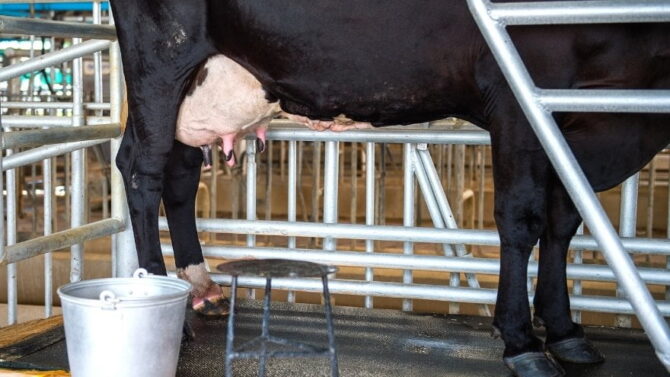
When discussing the sexes, different terms are used. These terms include cow, heifer, stag, steer, and bull. Before determining the gender differences, we need to clarify these terms:
- The cow is a female that has given birth to at least one calf. Though the word is used to identify every cattle, it is more specifically used for a mother.
- A bull is a male used for breeding. This male remains intact, which means he hasn’t been castrated.
- A heifer is a young female that hasn’t given birth yet.
- A steer is a young male that was castrated before it got to its sexual maturity.
- A stag was also castrated but after its sexual maturity.
The simplest way to differentiate a bull from a cow is to look down. Cows have udders that the calf can get milk from. However, bulls have no udders. In its place, they have testicles.
The castrated steer and stag have no testicles, which immediately separates them from the bull. They might also be less gregarious.
The difference between the cow and the heifer is more subtle. Usually, a female between 1 and 2 years is still a heifer as she has not reproduced. Any female with at least a calf is a cow.
Frequently Asked Questions
Are cows dangerous?
When unperturbed, cows are relatively safe. However, both bulls and female cows can be dangerous. Most people tend to be more scared of bulls because of what we see in movies. However, cows with little calves are more dangerous, as this study asserts.
Do cows fall in love?
Cows experience complex emotions, not just the basic feelings of stress and contentment. They can feel love, excitement, sadness, and even fear, as the case may be. While they do not seem to show romantic affection for the opposite gender as humans do, they bond with members of their herds and can even make friends.
How many cows are there in the world?
On an estimate, there is one cow for every seven humans on earth. While there’s no precise number, as more calves are birthed constantly, the population is said to be over 1.4 billion.
Are cows female?
Technically, the term ‘cow’ refers to female bovines. However, the term is now used as a general word for cattle, regardless of gender.
Are cows wild animals?
Cows were domesticated from wild cattle called aurochs, but except in very rare cases, modern ones aren’t wild. They are bred mainly on farms for various reasons.
Conclusion
The stereotype we have about these farm animals does them no justice. Cows aren’t dumb shallow animals only fit for milking and beef.
They are intelligent mammals with a complex range of emotions that help them bond with others and survive.
They have a lot of unique traits that help them stand out, and whether you’re a meat eater or vegan, you’d agree that they should be treated with kindness.
